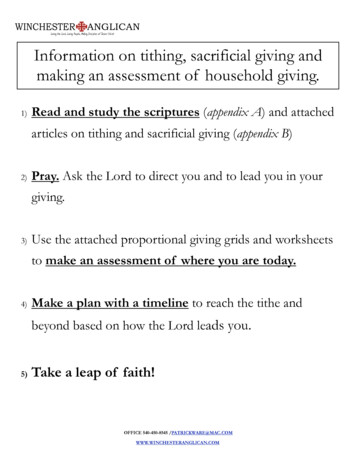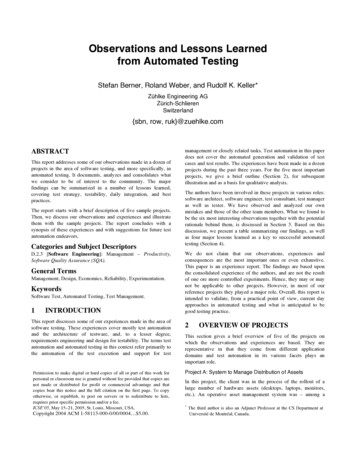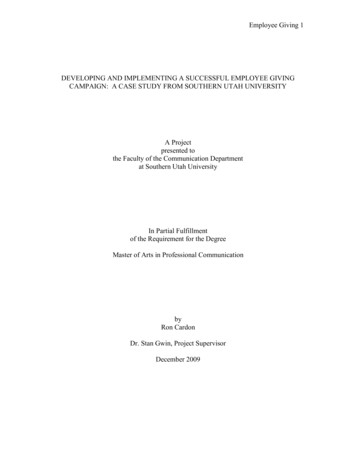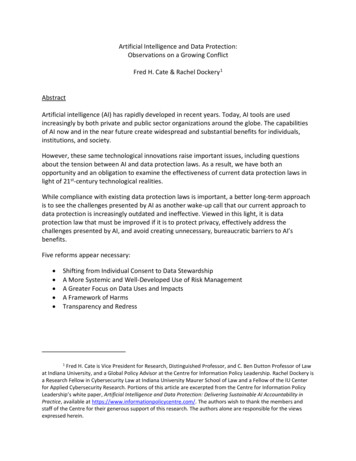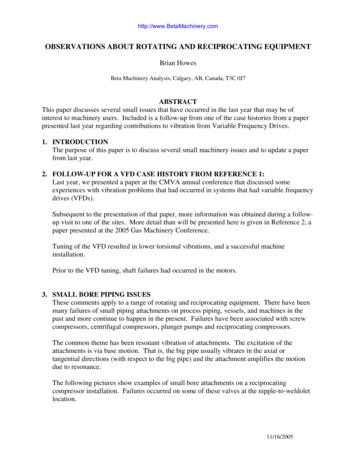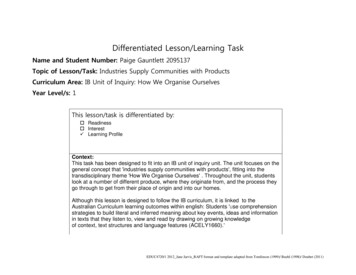
Transcription
CIGC12 8/31/05 10:53 AM Page 26512Making Observations andGiving FeedbackGroup Skills PreviewIn this chapter, you will learn to do the following: Explain why a group could benefit from feedback Distinguish between types and levels of feedback Complete and interpret an interaction diagram Persuade your group to try audio- or videotaping meetings to obtainfeedback Help your group initiate and design a feedback system Give effective feedback in one of your groupsroup success depends heavily on the degree to which group members effec-Gtively interact with one another. Groups that meet over an extended time—from just a few meetings to meeting every week—are more likely to effectivelyperform their tasks and create positive relationships among members if the groupcreates a feedback system (Dominick, Reilly, & McGourty, 1997). A feedback systemincludes two separate activities. The first is setting up a system for monitoring,observing, or collecting data about group and individual group member performances. The second is setting up a system for using that data as feedback for groupmembers. By considering both positive and negative features of the group and itsprocess, a group can use feedback to strengthen its performance.What Is Feedback?Feedback can be information about the quantity or quality of a group’s work,an assessment of the effectiveness of the group’s task or activity, or evaluations ofmembers’ individual performances. To be most effective, feedback should be anobjective evaluation of individual group members’ performance or the actionsof a group, not one member’s opinion or subjective evaluation. The feedbackdescribed in this chapter is not part of a formal performance evaluation system;an outsider does not evaluate the group. Rather, feedback is generated for thegroup by the group itself.Feedback, as we are interested in it, is a group process that serves as an errordetection device to help a group identify and begin to solve its interaction problems.265
CIGC12 8/31/05 10:53 AM Page 266266Chapter 12 Making Observations and Giving FeedbackThus group members generate their own feedback. Group members are bothparticipants and observers, with observations aboveboard and apparent to othergroup members. Group members who trust one another can assume theseadditional group roles. The most effective group is one in which all memberscontribute feedback information (Keltner, 1989). When trust develops amonggroup members, a bond exists to help each group member perform as effectivelyfor the team as he or she can. When individuals are drawn this tightly into a group,their interdependence is extremely high. By investing in one another through observation and feedback, interdependence is strengthened.Why Groups Need FeedbackGroups that meet over a period of time require a great deal of time, energy, andother resources. Generally, group members are interested in performing well,making effective decisions, and creating positive relationships. Feedback can helpgroup members understand how their groups work and how to make them workbetter (Schultz, 1999). That is, feedback helps the team or group learn about itself.Some groups that integrate performance feedback into their activities think ofthe group as a place of continuous improvement. However, “unless a team has dataabout how it is doing . . . there is no way it can learn. And unless a team learns,there is no way it can improve” (Hackman, 2002, p. 103).Of course, by paying attention to how others react to them, group membersare getting some feedback from other group members. Unfortunately, without anagreed-upon system for generating feedback, group members are likely to receiveMany of us are biased about our responsibility to groups. If the group succeeds, we tendto believe that the group’s success should be attributed to us personally. If the groupfails, we blame the group and avoid taking responsibility for its failure. We are moreeffective group members and a greater asset to our groups when we recognize this typeof attribution bias.
CIGC12 8/31/05 10:53 AM Page 267Why Groups Need Feedbackbiased feedback. Typically, you are more likely to give detailed feedback when theinformation is negative or the team or group has suffered a loss, and to give general feedback when the information is positive or the team or group is glowingafter a success (Nadler, 1979). Feedback can also be biased by another tendency.When asked how you contributed to a group’s success, most of you wouldreply that you were personally responsible. But when asked how you contributedto a group’s failure, you would probably avoid taking that responsibility. This attributional bias is common in group members. Virtually without exception, membersclaim personal responsibility when their group is successful and deny personalresponsibility when their group fails (Forsyth & Kelley, 1994). This type ofself-serving bias may cloud your judgment, keeping you from recognizing yourtrue impact on the group. Another factor figures in here as well. Some peopleare optimists—they expect things to generally go well. Conversely, some arepessimists—they expect things to generally turn out poorly. Personality traits likethese can also cloud your judgment of your impact on group interaction. Feedback—or information that evaluates or judges your communication performance—isone type of tool or intervention that can help you overcome this bias and improveyour abilities as group members. Feedback also improves the functioning of theteam. In successful teams, everyone is accountable all of the time (Larson &LaFasto, 1989). Thus each team requires some system of checks and balances—both at a team level and at an individual group member level. If you are stillwondering whether a group really needs feedback about how well its membersare communicating, consider this: Nearly 75 percent of all group problems arelinked to interpersonal problems and poor communication (Di Salvo et al., 1989).Initiating a feedback system in a group provides several benefits. First, groupmembers who believe that their input to the group will be evaluated are less likelyto become social loafers—those members who hide behind the efforts of othergroup members. Groups that include regular evaluation of group members automatically decrease the likelihood of social loafing. The evaluation process andpotential feedback about individual performance usually motivate potential socialloafers to take on other, more productive roles in the group.Second, when feedback is regularly provided in a group, member identification with the group is enhanced. Members of effective and successful groups arecommitted to their continuing success. They want to know how they are performing and how they can increase their communication effectiveness in the group. Asa result, their identification with the group is enhanced, and they become morecommitted to the group, creating stronger interdependence among group members.Third, at the group level, group members who receive positive feedback abouttheir group’s performance and their interactions are more likely to be satisfiedwith group member relationships, believe that their group is more prestigious,be more cohesive, and believe that group members are competent at their task oractivity (Anderson, Martin, & Riddle, 2001; Limon & Boster, 2003). Receivingpositive feedback sets off a spiral, causing group members to enhance their beliefsabout the group. As a result, group members are willing to mobilize and coordinate their skills, the amount of effort they are willing to put into the task, and their267
CIGC12 8/31/05 10:53 AM Page 268268Chapter 12 Making Observations and Giving FeedbackPUTTING THE PIECES TOGETHERGroup Goal, Interdependence, and Group IdentityGroupSizeGroupIdentityHow group members give and receive feedback can helpthe group achieve its goals or weaken relationships amongInterdependencegroup members. Feedback, even about relational issues,should always be grounded in the group’s goal or task.GroupGroupStructureGoalReflect on your last group meeting. What feedback mighthave helped the group? specific group members? you? Ifyou had the opportunity, how would you have constructedand delivered feedback to help the group become more effective? Would it havebeen difficult or easy to persuade everyone to participate in both giving andreceiving feedback? How do you think giving and receiving feedback affects groupmembers’ interdependence and identity? What fears do you have in giving andreceiving feedback? What about the fears of other group members?persistence when faced with challenges (Bandura, 1986). Groups wanting to besuccessful need feedback to identify their strengths so they can capitalize on them.And groups wanting to turn failure into success need feedback to identify theirweaknesses so they can make improvements. “Group Goal, Interdependence, andGroup Identity” can help you explore the feedback process.Levels and Types of FeedbackTo be effective, feedback must be specific. Feedback differs in two characteristics:(a) the level, or to whom feedback is generated or what feedback is about, and(b) the type, or the intent or function of the feedback.Levels of FeedbackFeedback can occur on many levels. Feedback may focus on how the group isworking with procedures, how an individual is handling a specific group role inworking with others, how one member sits silently saying nothing, how the groupis dealing with a conflict, or how the organization is using the information thegroup provides.Task and Procedural Feedback Feedback at the task or procedural level usuallyinvolves issues of effectiveness and appropriateness. Issues of quantity and qualityof group output are the focus of task feedback: Did the team win? Did the groupraise enough money? To what extent did the group’s presentation satisfy thejudges? Thus, task feedback focuses on the outcome of the group’s activity.Procedural feedback provides information on the processes the group used toarrive at its outcome. Is the brainstorming procedure effective for the group? Didgroup members plan sufficiently? Questions like these focus group members’ attention on the task dimension of their activity. Groups need this level of feedback,
CIGC12 8/31/05 10:53 AM Page 269Levels and Types of Feedbackespecially after trying a new group procedure or passing a major milestone in thegroup’s development.Relational Feedback Feedback that provides information about the groupclimate or environmental or interaction dynamics within a relationship in the groupis relational feedback. This feedback focuses group members’ attention on howwell they are working together rather than on the procedures used to accomplishtheir tasks. Questions that focus on the relational dimension of the group includeDid the group manage conflict effectively? Were the leadership needs of thegroup adequately fulfilled? Did working on the task enhance cohesiveness amonggroup members?Individual Feedback Feedback that focuses on specific group members is individual feedback. This feedback may address the knowledge, skills, or attitudes agroup member demonstrates or displays. A good place to start is with seven characteristics that affect an individual’s ability to be an effective group member(Larson & LaFasto, 1989).The first is intellectual ability. Can the person secure relevant informationand relate and compare data from different sources? A group member who isanalytical or creative is especially helpful to his or her group. The second factoris results orientation. The group member who can demonstrate the ability to worktoward outcomes and complete activities helps further the progress of the team.The third factor—interpersonal skills—encompasses a group member’s ability torelate to the feelings and needs of other group members. The fourth factor is theability to plan and organize. The individual who is able both to schedule personaltime and to work within the schedules of others contributes to the accomplishment of group goals. Typically, group members must handle several activitiesat once and have the ability to meet competing deadlines. The fifth factor isthe individual’s ability to demonstrate a team orientation. Can the person workcollaboratively with others on complex issues? If so, the individual is revealing acommitment to the team on which others can depend. The sixth factor is maturity.The group member is considered mature when he or she acts responsibly whendealing with difficult people or situations. The final factor is presence or image.The person’s willingness to present a friendly impression reflects positively on himor her and on the team. The characteristics of an ideal group member describedin Chapter 5 apply here.Feedback can cover any or all of these issues. But, in general, group membersare going to respond to three main issues: (a) Do you demonstrate the essentialskills and abilities needed by the team? (b) Do you demonstrate a strong desireto contribute to the group’s activities? and (c) Are you capable of collaboratingeffectively with other team members? Remember that while you are being evaluated on these dimensions you are evaluating other team members as well.Group Feedback At this level, feedback focuses on how well the group is performing. Have team members developed adequate skills for working together?269
CIGC12 8/31/05 10:53 AM Page 270270Chapter 12 Making Observations and Giving FeedbackMASTERING GROUP SKILLSTopics for Group FeedbackAlthough each group is different and unique, most groups will benefit if you andother group members reflect on the following questions. How would you answerthese questions for one of your current groups? Would other group membersprovide similar responses?Goals of the Group1 . Are members committed to the goals of the group?2. Are members’ personal goals in alignment with the group’s goals?Roles in the Group1 . Are roles and responsibilities within the group clear to all?2. Who in the group is providing leadership?3. Is the group responding well to this leadership?4. Are other necessary roles covered by someone in the group?Procedures and Processes1 . Are group members communicating effectively together?2. Are decision-making procedures used appropriately?3. Is conflict managed?4. Does the group spend its time together effectively?General1 . What are the strengths and weaknesses of the group?2. Is someone or something outside the group hindering it?Use these questions to guide a feedback session at the end of a meeting. Youranswers could uncover issues that need to be addressed or resolved for yourgroup to succeed. Even if no difficulties are uncovered, the group will benefitfrom reviewing its direction.Does the role structure or communication network of the group support thegroup’s task and activities? Has the team developed norms for communicatingthat help it accomplish its goals? Are there adequate and appropriate levels ofgroup cohesiveness and group member satisfaction? Are the group’s leadershipfunctions being fulfilled effectively? Did the group develop a communicationnetwork that is conducive to its task? What decision-making procedures are groupmembers effectively using? How well is the group managing conflict when itoccurs?
CIGC12 8/31/05 10:53 AM Page 271Levels and Types of FeedbackFeedback at this level can have a dramatic impact on members’ attraction to thegroup, as well as their feelings of involvement and self-esteem. Certainly, feedbackto the group about its performance on its task increases group members’ motivations to improve their performance. The more interdependently group memberswork together, the greater the impact of group feedback concerning the task(Nadler, 1979). “Topics for Group Feedback” will give you some ideas for usingfeedback in your groups.Over time, it is important that a group receive both task feedback—feedbackabout the technical competencies or functional task activities of the team—andteamwork feedback—feedback about the group’s interactions and members’relationships, cooperation, communication, and coordination (McIntyre & Salas,1995). Using both task and teamwork feedback, a group can actually improve itsdevelopment over time.Types of FeedbackThere are three types of feedback—descriptive, evaluative, and prescriptive—eachof which has a different intent or function, and carries different inferences.Descriptive Feedback Feedback that merely identifies or describes how a groupmember communicates is descriptive feedback. You may describe someone’scommunicator style, or you may note that someone’s verbal communication andnonverbal communication suggest different meanings. For example, you say toAmber after a meeting, “You asked me to comment on how you communicatedwith others in the group. From my perspective, you were very dominant; youtalked a lot and seemed very active in the group. I also felt that you argued eachpoint introduced. Someone once told me that I was contentious when I did that.And you were precise. You said exactly what was on your mind.”Evaluative Feedback Feedback that goes beyond mere description and providesan evaluation or assessment of the person who communicates is evaluative feedback. For instance, after describing Amber’s communicator style as dominant,contentious, and precise, you follow up by saying that this style causes othergroup members to avoid talking with her. Amber asks what you mean by that.You let her know that members with a more submissive style find Amber’s styleoverwhelming, making it difficult for them to feel equal to her in the group.Not only did you describe Amber’s style, you evaluated her style as negativelyaffecting group member interaction. Too much negative evaluative feedbackdecreases motivation and elicits defensive coping attributions, such as attributingthe feedback to others. At the extreme, it can destroy group members’ pride intheir group. In these cases, group members are likely to spend additional timerationalizing their failures (for example, finding a way to see a loss as a win) (Nadler,1979). To be constructive, evaluative feedback that identifies group memberdeficiencies is best given in groups with a supportive communication climate inwhich trust has developed among members.271
CIGC12 8/31/05 10:53 AM Page 272272Chapter 12 Making Observations and Giving FeedbackIn contrast, favorable feedback generates motivation and increases feelingsof attraction among group members (Nadler, 1979). Let’s go back to Amber. Afteryour feedback, Amber has toned down her dominant style and has quit arguingminor points. You say, “Great job today, Amber. I thought today’s meeting wentmuch better. That’s due to you, of course.” Naturally, we assume that positiveevaluative feedback will have positive effects on a group. But can a group receivetoo much favorable feedback? Yes. A group inundated by positive remarks, particularly in the absence of negative evaluations, will start to distrust the feedbackas information and perceive it as insincere.Prescriptive Feedback Feedback that provides group members with adviceabout how they should act or communicate is prescriptive feedback. Forinstance, after a group meeting which you believe was ineffective, you ask a groupmember you trust, “Got any advice?” Brian responds that he too was upset byhow the meeting developed. “We’ve got to get the agenda to everyone sooner sothey can prepare for the meeting. Could you remind Sara to do that? She trustsyou, and you and she work together on other committees. If you’ll do that, I’lltalk with people informally after we get the agenda to remind them to get theinformation we need before the meeting.” In this instance, Brian’s feedback isprescriptive for you, the group, and himself. Try “Giving Specific Feedback”to develop your feedback skills.Observing the GroupA powerful way to demonstrate the effectiveness of group process or group memberrelationships is to audiotape or videotape a segment of a meeting. Listening to orviewing the tape and then discussing it can motivate group members to improvetheir performance (Walter, 1975). Many sports teams do this after every game—win or lose—to enable the team to review its mistakes and to see in what situationsthe players performed effectively.Before you suggest taping your group, let’s explore the effects taping can haveon groups. Some group members may be hesitant for their performance to becaptured on tape and so become less talkative in the taped meeting. Conversely,some members may use the taping as an opportunity to show off by clowningaround, making jokes, or talking more than usual. Usually, such behaviors diminishas the meeting progresses if other members avoid drawing attention to the tapingprocess. Once the camera or tape player is set up, check to make sure it is workingcorrectly and then leave it alone until the end of the meeting or until a groupmember asks that the recording device be turned off. If a group member makesthis request, it should be honored without discussion or explanation.A tape of your group’s interaction provides a record of what you did (or didnot) say, as well as how you said it. Hearing how you communicated in the groupcan help you determine which of your communication skills need improvement.Taping a group’s interaction also helps the group as a whole determine how wellits members work together. Taped interactions are undeniable testaments to who
CIGC12 8/31/05 10:53 AM Page 273Observing the GroupSKILL BUILDERGiving Specific FeedbackLearning to give effective feedback takes practice. Listed here are examples offeedback statements taken from transcripts of group meetings. The examples showboth the intent of the feedback and the actual feedback given. After considering thelevel and type of feedback, evaluate the feedback given. If you think it is lacking inany way or is likely to be ineffective, rewrite the feedback to be more effective.Level and Typeof FeedbackFeedback GivenIndividual, positive“Connor helped us focus on the realarguments when he asked each of us todescribe why we felt the way we did.”Group, positive“We did a great job, guys.”Group, negative“I think we all could do a better job ofmanaging our tempers.”Evaluative, relational“Mark, next time, why don’t you justbring a gun and shoot Darius? Youwere mad at him the entire meeting.”Descriptive, group,task/procedural“We made four decisions, each with adifferent decision-making strategy.”Negative, group,relational, prescriptive“We have to get along better.”Your FeedbackSuggestiontalked and who did not, to whose ideas were listened to and whose were not, and towhat decision procedures worked and what ones did not. Groups, like individuals,can fall into patterns of communication. Periodically, you need to do an assessment of both.When the group is ready to listen to or view the taped proceedings, it is bestto focus on one aspect of the group’s communication. For example, you couldsuggest that your group count the number of times talking turns were interruptedor assess the degree to which group members satisfied the five critical decisionmaking functions described in Chapter 7.An analysis of taped proceedings will be more effective if you avoid focusingon specific group members. For example, it is better to analyze how the groupmaximized use of its leadership than to focus only on the leader’s communicatorstyle. In the former case, group members could listen to or view the tape to assesswhich leadership roles were distributed among group members and whether the273
CIGC12 8/31/05 10:53 AM Page 274274Chapter 12 Making Observations and Giving Feedbackgroup successfully avoided a pattern in which the leader talks after every membercontributes. These are issues for which the entire group is responsible.If you captured the group’s interaction on video or DVD, you can also identifythe structure of the group’s communication network by drawing an interactiondiagram of who talks to whom. First, draw a diagram to represent where groupmembers are sitting. The first time a group member speaks, draw an arrow to theperson to whom the message is directed. If the message is directed to the groupas a whole, the arrow points away from the group (for ease in seeing the network).For each subsequent message, place a hatch mark across the arrow.At the end of the interaction, the diagram will represent both the frequencyand flow of messages sent to individual group members and to the group. Anexample of an interaction diagram is displayed in Figure 12.1. Before each tournament this baseball team meets for a strategy session. In just a few minutes ofinteraction, it is easy to see how the flow of communication is developing in theteam. As expected, the coach and the team leader, who also plays first base, sendthe most messages to the group and specific group members. Notice also how asubgroup has developed among the right, left, and center fielders, and among thepitcher, catcher, and first base player. This isn’t unusual, given that this is a meetingto develop game strategy. Also notice that the coach speaks most frequently toteam members who sit across from him. This is not unusual either. The secondbase player and right fielder sitting immediately next to the coach are out of hisline of sight. Finally, notice the second base player. He is the most isolated ofteam members. Remember, though, that the coach, first base player, center fielder,shortstop, and catcher are sending messages to the group as a whole. While noone is sending messages directly to the second base player, he is receiving themessages that are communicated the group as a whole.Recall the description of communication networks in Chapter 3. Analyzingthe diagram will help you to determine if the group has a centralized or decentralized network. This will reveal the degree of interdependence among membersor their subgroups, as well as disparity in the frequency of member contributionsor the pattern of group messages. Recall also that who talks to whom is just onetype of communication network. An interaction diagram does not capture thequality of members’ interactions. Thus, you must analyze the diagram relative towhat the group was trying to accomplish in its interactions.Although the focus of this chapter is on giving feedback to a group in whichyou participate, observing other groups and creating interaction diagrams of theirmeetings will make you more aware of how messages are exchanged in groupsettings. City councils and other governmental groups (such as planning commissions) hold public meetings anyone can attend. In some communities, thesemeetings are also broadcast on local cable channels. Listening and observingother group meetings can help you identify and recognize patterns of group conversation that, if you were participating, may go unnoticed. Although it’s unlikelyyou’ll have the opportunity to provide feedback to these groups, considering whatyou would give as feedback will strengthen your skills in giving feedback in yourgroups.
CIGC12 8/31/05 10:53 AM Page 275Starting a Group Feedback leader/first ure 12.1 Example of an Interaction DiagramStarting a Group Feedback SystemIt can be difficult to initiate a feedback system in groups. Often, this will be groupmembers’ first experiences with feedback and observation techniques. Here isone way of developing a feedback system that increases incrementally over timeuntil a fully developed system is operating in the group. First, recognize thatgroups and members do not want to hear only negative feedback—feedbackfocused on what is not working. If a group hears only negative feedback, eventually its ability to function is seriously damaged (Smith & Berg, 1987). Groups andmembers are more likely to accept negative feedback when positive feedback isalso included.Observation and Feedback ProcessFor groups that have not used feedback systems before, start by introducing andexplaining the concept of feedback at the end of one meeting. Individuals areoften hesitant to disclose what they think or feel to others. To ease the group intothe feedback process, ask each group member to write down three things thatwent well in the group session and three things that did not work so well. Focustheir efforts on the task and procedural or the group level of feedback—how wellthe group worked together, how conflicts about which procedure to use keptthe group from making a decision, how extensively group members shared the275
CIGC12 8/31/05 10:53 AM Page 276276Chapter 12 Making Observations and Giving Feedbackleadership function, or how well the group was able to work through its agenda.The idea here is to get group members started thinking critically about the group’sprocess.Starting with yourself, ask group members to alternate reading first a positiveand then a negative comment until all of the comments are before the group. Youmay want to ask someone to write these down on a chalkboard or flip chart. Evenif every group member chooses the obvious positives and negatives, the conceptof feedback has been introduced in the group. Now, with the positives and negatives before the group, ask group members to select one positive that they willremember and use at the next meeting, and one negative that they can work ontogether at the next meeting. Before adjourning, ask each member to write downspecifically what he or she will do to help the group overcome the negative thegroup selected. With this procedure, you call attention to the feedback processand stimulate members’ thinking about how well the group is operating.At the end of the next meeting, ask group members to repeat the process justdescribed and to also write down three things they did that contributed to thegroup’s success and three things that they could improve on to help the group.Then repeat the round robin disclosure of the group-level task or
biased feedback. Typically, you are more likely to give detailed feedback when the information is negative or the team or group has suffered a loss, and to give gen-eral feedback when the information is positive or the team or group is glowing after a success (Nadler
